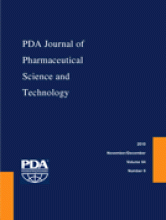Abstract
The objective of this study was to examine the role of dimension and design of stoppers on the vapor transfer rate during the lyophilization process. Glass vials (100 cc, 28-mm neck diameter) containing mannitol solutions (4% w/w) were fitted with specially designed Teflon discs with circular holes (area ranging 0.12 to 41.80 mm2) instead of stopper vents, which served as the vent for water vapor transfer. The rate of vapor transfer across the vent, the temperature of the frozen product, and the vapor pressure inside the vial were monitored during the early primary drying phase. It was observed that the rate of vapor transfer from the vial increased as the cross-sectional area of the vent was increased. However, this increase tapered off as the area of the vent approached approximately 6 mm2 in the case when the shelf temperature was at 0 °C and 10 mm2 in the case when the shelf temperature was at 25 °C. Despite the higher accumulated pressure inside the vial and the corresponding higher temperatures of the frozen product, the rate of water vapor transfer across the vents was lower at the smaller vents, suggesting that the vapor transfer flow regime was under the choked conditions. Mathematical modeling using the observed water vapor pressure values inside the vial indicated that the flow pattern transitioned from the choked to non-choked pattern at a point where the ratio of pressure in the vial to pressure in the chamber, Pvial/Pchamber, was 2.5.
In another set of drying experiments using stoppers with various vent configurations (1-leg, 2-leg, and 3-leg) in glass vials (100 cc, 20-mm neck diameter) containing 4% w/w mannitol solutions, there was no statistical difference in the rate of drying among the three stoppers. The temperature of the frozen product/vial pressure profiles was also similar. This is due to the fact that the vent areas in all the cases were above ∼20 mm2 and coincided with the plateau region where mass transfer was not the rate-limiting factor across the vent areas. Partial blockage of the vent areas, even up to 50%, did not affect the rate of drying in any of the stoppers, whereas blockage of the vent areas of >75% did decrease the sublimation rate by 25%.
LAY ABSTRACT: The objective of this study was to investigate if the dimension and the design of stoppers may affect the moisture vapor transfer rate during the lyophilization process. The rate of vapor transfer across the vent, the temperature of the frozen product, and the vapor pressure inside the vial were monitored during the early primary drying phase in vials that were fitted with specially designed Teflon discs with circular holes (area ranging from 0.12 to 41.80 mm2) instead of stoppers. It was observed that although the rate of vapor transfer from the vial increased with the cross-sectional area of the vent, the increase tapered off as the area of the vent approached approximately 6 mm2 in the case when the shelf temperature was at 0 °C and 10 mm2 in the case when the shelf temperature was at 25 °C. Despite the higher accumulated pressure inside the vial and the corresponding higher temperatures of the frozen product, the rate of water vapor transfer across the vents was lower at the smaller vents, suggesting that the vapor transfer flow regime was under the choked conditions.
Studies with various stopper configurations (1-leg, 2-leg, and 3-leg) and vent areas also showed that as long as the vent areas are greater than the critical mass transfer restriction threshold then there should not be any difference in the overall drying behavior and that substitution of stoppers within the range should yield similar drying cycles.
- © PDA, Inc. 2010
PDA members receive access to all articles published in the current year and previous volume year. Institutional subscribers received access to all content. Log in below to receive access to this article if you are either of these.
If you are neither or you are a PDA member trying to access an article outside of your membership license, then you must purchase access to this article (below). If you do not have a username or password for JPST, you will be required to create an account prior to purchasing.
Full issue PDFs are for PDA members only.
Note to pda.org users
The PDA and PDA bookstore websites (www.pda.org and www.pda.org/bookstore) are separate websites from the PDA JPST website. When you first join PDA, your initial UserID and Password are sent to HighWirePress to create your PDA JPST account. Subsequent UserrID and Password changes required at the PDA websites will not pass on to PDA JPST and vice versa. If you forget your PDA JPST UserID and/or Password, you can request help to retrieve UserID and reset Password below.






